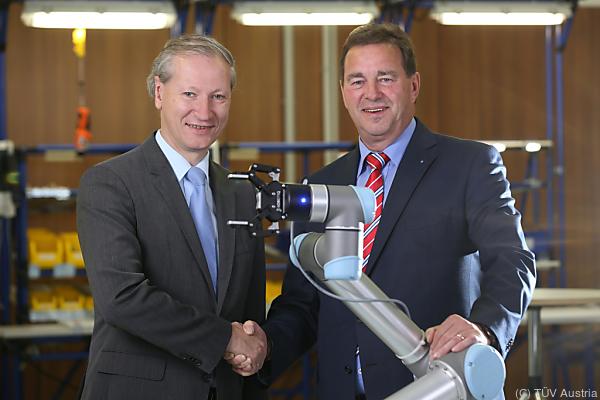Robots as co-workers – assistance or hazard?
- 08/04/2016
- Industry & Energy Marketing
- Created by APA-Science
“The automated production lines currently in use are located behind safety guards. Like animals in the zoo, they are ‘behind bars’ and have no contact with the workers. But now that the railings are disappearing, feelings of anxiety are the result”, Christoph Schwald, Innovation Manager at TÜV AUSTRIA, explained in an interview with APA-Science.
The advantages of so-called collaborative robotics are clear: firstly, humans no longer have to do physically taxing or routine tasks, which is of major importance considering the increasing age of the workforce. For example, a robot can lift and position a heavy workpiece while a person welds on light iron hooks. Secondly, robots help increase productivity and quality.
The fact that robots are now being “released” poses entirely new challenges to safety: “There are two dimensions: the first is machine safety, meaning that the machine must be programmed such that it cannot hurt people. The other is cyber security, such as protection from hacker attacks. This is often neglected”, according to Schwald. However, both aspects must be taken into account and explored in collaborative robotics. “Because safety and security are of the utmost importance particularly in this field. If serious accidents were to happen, this would mean the end of this technology.”
Sensor and actuator technology already highly advanced
In contrast to conventional robots, which had become a risk as they kept getting faster and larger, collaborative robots are usually not considered a hazard by comparison – provided an appropriate safety policy is in place. “The sensor and actuator technologies are by now so advanced that robots can be designed such that they operate without posing a threat. If they happen to come too close to a human, they stop”, Wilfried Sihn, CEO of Fraunhofer Austria and Head of the Institute of Management Science at TU Vienna, clarified.
“Dumb” robots will continue to exist because there are certain tasks that are best carried out by them on their own. “Collaborative robots are used for very different applications, such as to assist with assembly. In comparison, they are ten times smaller but five times more efficient”, Sihn explained. They have neither the strength nor the speed to cause serious harm to people, provided that the various rules associated with several sub-fields – from occupational safety through to control technology – are complied with. This is precisely what is being investigated in the current project.
The challenge is that the given task – robots working together with humans in production – is a completely new one. “We first have to determine what to examine and how in order to be able to guarantee that a system environment is safe for humans”, the expert said. For example, it must be ensured that a robot stops when the force sensor measures that a certain value with which it acts on a human is exceeded. “We are exploring the human-robot collaboration in detail so as to enable the safe use of robots and to clarify outstanding safety issues, which so far have stood in the way of widespread use in industry”, Stefan Haas, CEO of TÜV AUSTRIA Holding, described the project objective.
Given the many aspects that need to be considered, the undertaking is highly complex. “The robot is programmed depending on the respective application and workpiece, and is assigned various speeds. It can move faster handling a round, lightweight workpiece because it cannot hurt a nearby worker with it”, according to Schwald. “Things get even more complex when taking into account that different parts of the human body are more or less prone to injury. A blow to the arm is not as bad as one in the face.”
Concern among many companies
The first dedicated standard, the “biomechanical limit values”, are now available. Jointly developed by the German Social Accident Insurance (Deutsche Gesetzliche Unfallversicherung, DGUV) and various universities, they regulate, among other things, the force that may be used by a robot when touching a human on various parts of the body. “For a collaborative robot to be used safely, it must be programmed according to these limit values, and this has to be verified as well”, the TÜV manager explained. Manufacturing companies are greatly concerned about finding a way to ensure the safety of their employees.
According to the experts, the technology has great potential nonetheless: “Collaborative robotics is the future of industrial work, and it will eventually be used in other fields as well. But this does not mean that humans are being replaced”, Sihn clarified. Schwald expects a considerable boost in development as a result of further technological advances: “In five years’ time, robots may not only be able to feel when they are being touched but may become aware of someone close by even before that by means of cameras or inductive sensors. There are numerous ongoing research projects in this field”, the innovation expert pointed out.
Stefan Haas and Wilfried Sihn (right) shake hands on their collaboration © TÜV AUSTRIA, Andreas Amsüss

